ABOUT

Although not often included in the category of “space weapons,” ground-based capabilities are the most common systems used to interfere with, damage, or destroy satellites.
Ground-based antisatellite weapons (ASATs) direct kinetic, nuclear, or directed-energy force from Earth to targets in space. Satellite systems can also be the subjects of Earth-based electromagnetic and cyber interference.
Kinetic ASATs, which are classified as conventional weapons, use physical force to damage or destroy their targets. Direct ascent weapons, which use missiles or projectiles to attack satellites, are closely related to antiballistic missile (ABM) defence systems; modified antiballistic missiles have often been tested against space objects.
Kinetic ASAT capabilities date back to the early space age, but no hostile use of them has been recorded. However, the development, testing, and demonstration of such capabilities are accelerating.
KINETIC ASATS AND SPACE SECURITY
Beyond their ability to damage or destroy targeted satellites, ground-based kinetic ASATs have the potential to indiscriminately threaten other objects in orbit and the sustainability of the space environment through the production of space debris (see related Issue Guide on debris and anti-satellite weapons). China’s use of a ground-based missile in 2007 to intentionally destroy a satellite created one of the largest debris clouds on record.
Capabilities for ground-based kinetic attacks on satellites are proliferating and risks accelerating an arms race in outer space. However, this dynamic is not exclusive to space activities, but extends to other domains of military activity and competition.
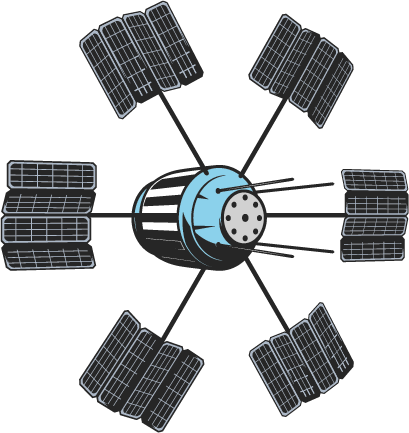
TYPES OF KINETIC ASATS
There are different types of Earth-based kinetic ASAT weapons:
• In a direct ascent attack, also called kinetic-kill, a projectile (commonly known as a ‘kill vehicle’) is launched from a land, sea, or aircraft-based platform to strike and damage or destroy a satellite through kinetic force.
Because it is precise, this has been the most common type of ASAT weapon developed and tested to date. However, it is feasible for more rudimentary forms of kinetic force to be deployed against objects in space.

• A pellet cloud attack releases a cloud of pellets in the path of a target satellite.
• A conventional explosive weapon can be detonated near the target satellite.
These weapons are much less precise, and their effectiveness against a target less certain. Critically, they have a high potential for indiscriminate effects on other space objects.
WHAT CAPABILITIES MUST A KINETIC ASAT WEAPON HAVE?
In addition to a projectile or explosive device of some sort, most kinetic ASATs require other advanced enabling technologies. Direct ascent kinetic-kill attacks, in particular, must be supported by a suite of sophisticated surveillance, tracking, and targeting capabilities.
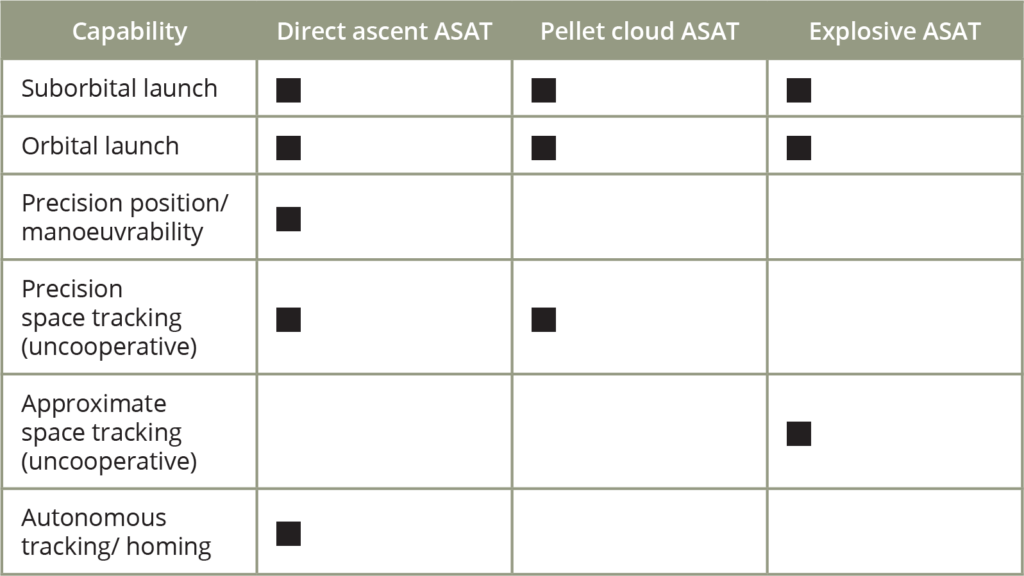
WHICH STATES HAVE DEMONSTRATED A GROUND-BASED KINETIC ASAT CAPABILITY?
By late 2020, the United States, China, and India had conducted direct ascent kinetic intercept demonstrations, using their own satellites as targets.
The former Soviet Union and later Russia used various co-orbital weapons to demonstrate the use of kinetic force against objects in space (see related Issue Guide on co-orbital weapons).
The first direct ascent intercept of a satellite was demonstrated by the United States in 1963; a modified Zeus B nuclear-tipped missile targeted a spent rocket stage in orbit. Nuclear explosions in space have since been banned.
In 1984, the United States developed the ASM-135 Air-Launched Miniature Vehicle. The missile was mounted on an F-15A aircraft and could intercept targets in low Earth orbit (LEO). An intercept test against a U.S. satellite was conducted in 1985. Another direct ascent ASAT system, the Kinetic Energy ASAT program, was developed in the 1990s, but never tested against a space object.
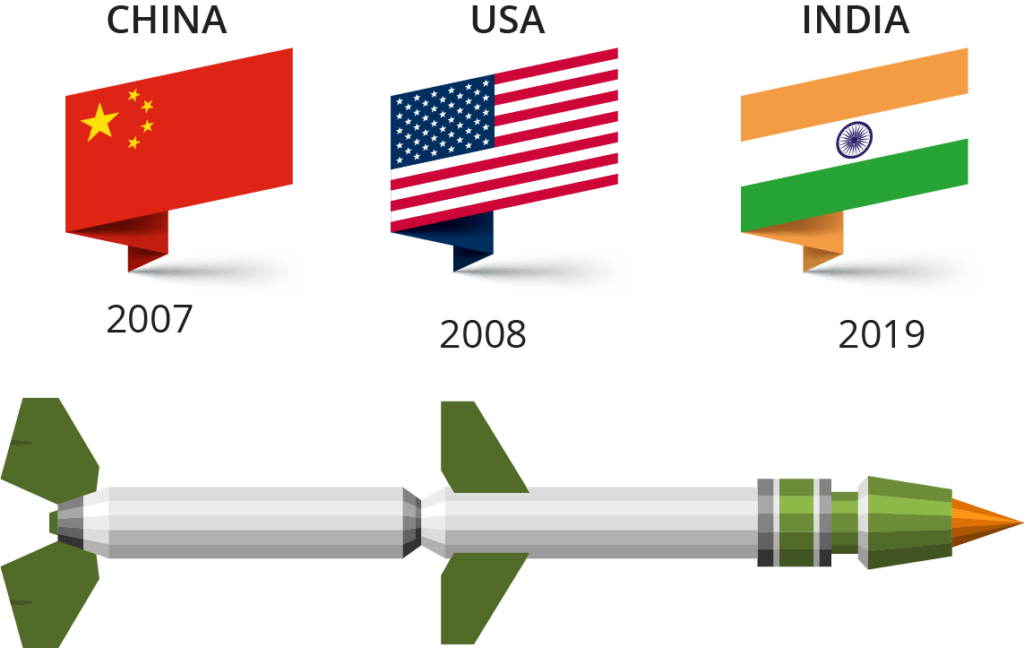
The modern era of direct ascent, kinetic ASAT testing began in 2007 when China used what is believed to have been a midrange ballistic missile (designated SC-19 by the United States; known as DN-21 in China) to destroy the aging Chinese FengYun 1C weather satellite in LEO.
In 2008, the United States demonstrated its ability to intercept a satellite in LEO, using what was described as a one-time modification of a Standard Missile 3 (SM-3) interceptor launched from the Aegis sea-based missile defence system. The target was U.S. reconnaissance satellite USA-193, which was re-entering Earth’s atmosphere and, according to the United States, threatened to cause damage from its unspent, toxic hydrazine fuel.
In 2019, India conducted “Mission Shakti,” in which a Prithvi Defence Vehicle Mk II antiballistic missile intercepted an Indian military Microsat-R
satellite at an altitude of approximately 300 kilometres (km).
Besides these few kinetic intercepts, China, India, Russia, and the United States have performed many non-destructive flight tests of direct ascent ASAT capabilities. Targeting a predetermined point in space or conducting a close-proximity flyby to a target tested the components of a system as well as its reach and accuracy. Such tests also communicated capabilities to adversaries.
HOW MANY DIRECT ASCENT ASAT TESTS HAVE BEEN CONDUCTED?
Information compiled by the Secure World Foundation on the history of ASAT testing indicates that as of June 2020, there had been 50 direct ascent anti-satellite tests, five of which intercepted objects in orbit.
DIRECT ASCENT SATELLITE TESTS
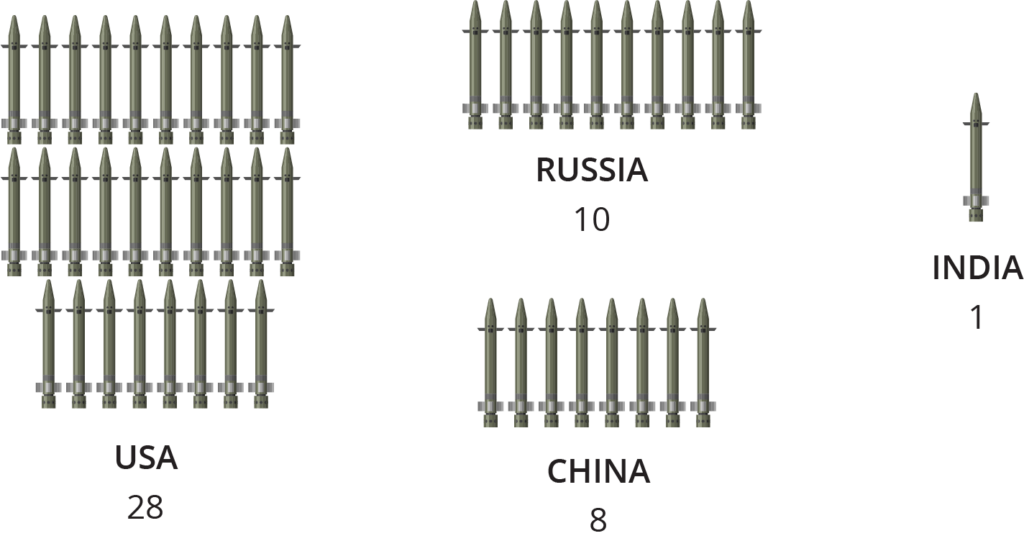
WHICH SATELLITES ARE VULNERABLE TO GROUND-BASED KINETIC ASATS?
So far, all direct ascent intercept tests and demonstrations have been conducted in low Earth orbit, the location of the vast majority of commercial satellites and many military reconnaissance satellites.
However, there is evidence that China has conducted flight testing of kill vehicles as high as geostationary (GEO) orbit, roughly 36,000 km above the Earth. Historically, communications satellites have been located in GEO; so are strategically sensitive military satellites that are used for command and control of military forces and nuclear weapons systems.
MISSILE DEFENCE SYSTEMS AND ASATS
Ballistic missile defence systems have an inherent use as kinetic ASAT systems. Their abilities to target, hone in on, and intercept ballistic missiles can be modified for use against satellites in orbit. Indeed, in some ways it is easier to identify, characterize, and track a satellite in orbit than a ballistic missile.
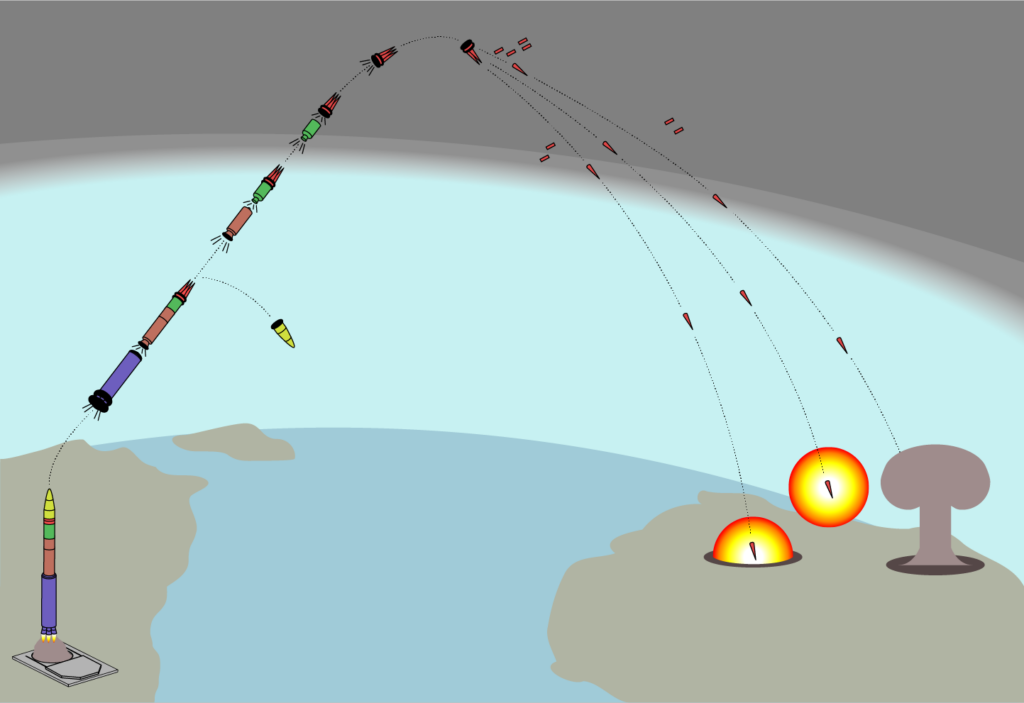
Throughout the space age, almost all direct ascent kinetic ASAT systems have been based on ABM platforms. All modern demonstrations of kinetic intercepts of satellites have used modified versions of these platforms.
Not all missile defence systems can reach objects in space. Theatre missile defence systems, designed to intercept short-range missiles, are not capable.
Systems designed to connect with intercontinental ballistic missile targets midcourse, when the incoming missile is at its highest trajectory in space (exoatmospheric), are best suited. The United States maintains two operational midcourse ABM systems:
• U.S. Ground-based Missile Defense (GMD) System: The system became operational in 2010; it currently includes 44 Ground-Based Interceptors, which are deployed across the United States. With a vertical intercept range of roughly 6,000 km it would be capable of targeting satellites in LEO, if modified. New interceptors and kill vehicles are being considered for the GMD system.
◦ Twelve of the 19 flight intercept tests conducted since 1999 have been successful
• Aegis system: This land- and sea-based missile defence system uses the Standard Missile 3 (SM-3) intercept missile. The SM-3 Block IA missile was modified in 2008 to intercept a U.S. military satellite as it re-entered Earth’s atmosphere. The SM-3 Block IA and Block IB missiles have a vertical range of 600 km and can only target some low orbiting satellites in LEO. The SM-3 Block IIA, a joint development by the United States and Japan, will be able to target most satellites in LEO with a vertical range of 1,450 km. The Aegis system is also operated by Japan.
◦ The Aegis system has successfully conducted intercepts in 40 of 49 tests.
China, India, and Russia have each developed ground-based ASAT systems using ABM capabilities.
CURRENT DIRECT ASCENT KINETIC ASAT CAPABILITIES
More terrestrial military systems capable of striking satellites with kinetic force are being developed and tested.
The United States does not have a dedicated, direct ascent ASAT program, but maintains two ABM systems that have an inherent ASAT capability, as described above.
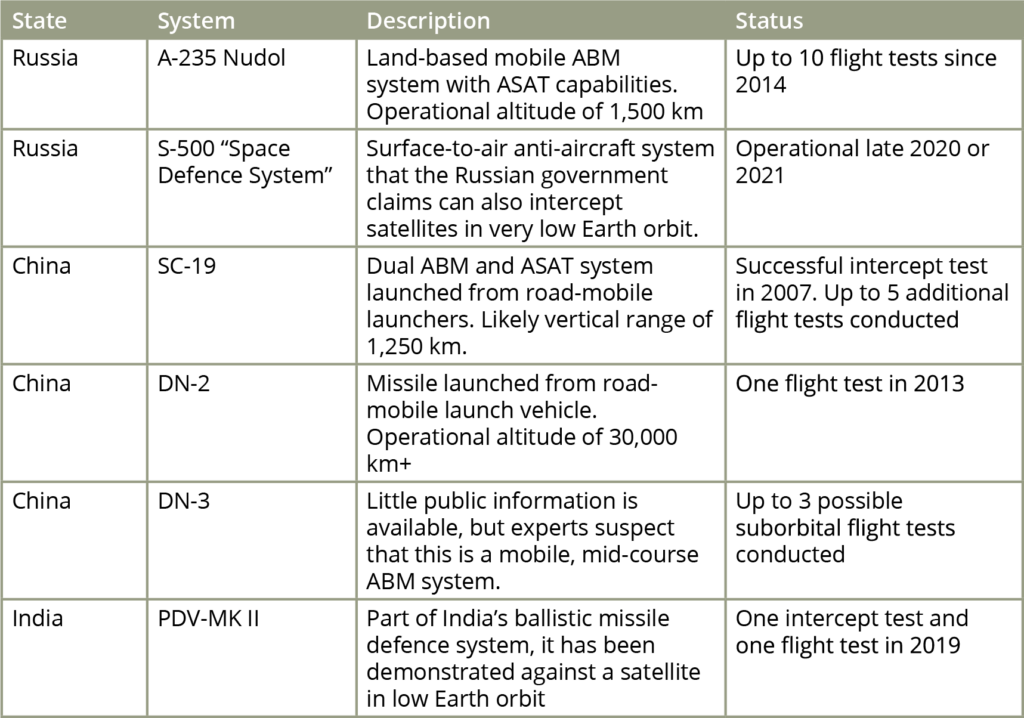
CHALLENGES
The use and testing of ground-based kinetic ASAT systems poses a number of challenges. The production of space debris is one of the most pressing. Most debris that has been generated by kinetic ASAT testing remains on orbit today (see related Issue Guide on debris and anti-satellite weapons).
The close connection between hardware used for direct ascent ASAT systems and ABM systems poses a challenge for the regulation or restriction of kinetic force in outer space.
The increase in the number of systems and states with a demonstrated kinetic ASAT capability is evidence of a growing arms race in outer space that is spurred on by regional insecurity. While the pursuit and testing of ASAT capabilities has become linked to military deterrence strategies, as Indian officials indicated following India’s 2019 test, it is not clear that ASAT capabilities have a deterrence effect. Rather than stabilizing the space security environment, the rising level of activity leaves all states less secure.
GOVERNANCE
There is no legal ban on the use of kinetic weapons in outer space, or the development and testing of such systems. Article IV of the Outer Space Treaty bans only the orbiting, placement, and use of nuclear weapons and other weapons of mass destruction.
In the final years of the Cold War, actors generally refrained from ASAT testing. In 1983, in response to the U.S. Strategic Defense Initiative, Russia declared a voluntary moratorium on such tests. After the 1985 ASM-135 test, the U.S. Congress stopped funding ASAT testing. This period of restraint ended with the Chinese test in 2007.
States at the United Nations First Committee on International Security and Disarmament overwhelmingly support an annual resolution on the “prevention of an arms race in outer space” (PAROS). However, related efforts to agree on new arms control measures at the Conference on Disarmament (CD) have been stalled for almost four decades. A draft treaty proposal titled “Treaty on the Prevention of the Placement of Weapons in Outer Space, the Threat or Use of Force Against Outer Space Objects (PPWT)” was submitted to the CD jointly by Russia and China in 2008 and again in 2014. Detractors claim that it does not specifically address the threats posed by ground-based weapons. An annual resolution at the United Nations First Committee on no first placement of weapons in space also does not pertain to the use of ground-based weapons systems.
A Group of Governmental Experts, convened in 2018-2019 to identify further practical legal measures for the prevention of an arms race in outer space, did not reach consensus.
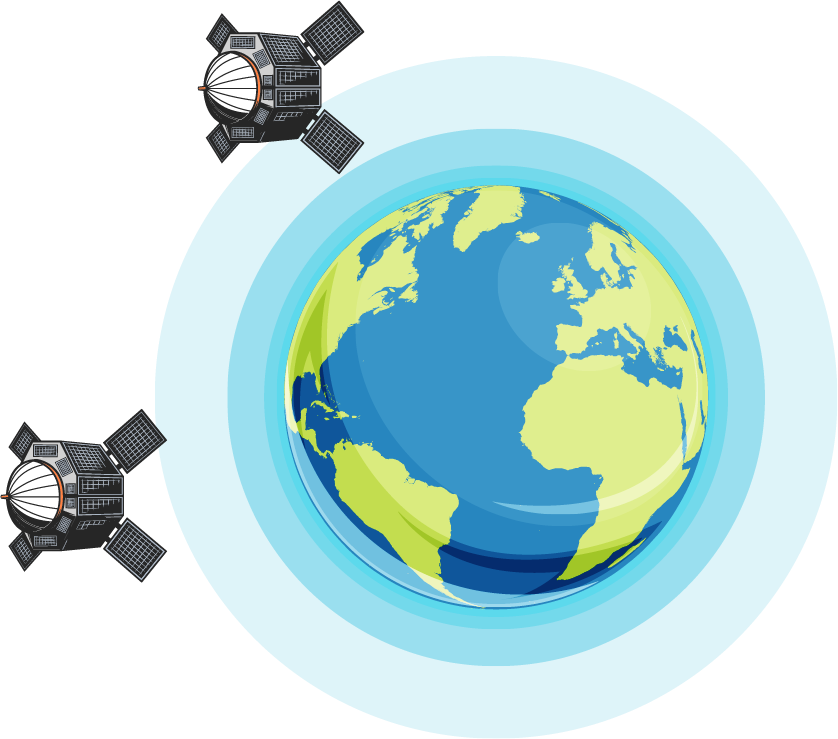
RESOURCES AND FURTHER READING
Dwayne A. Day, “To attack or deter? The role of anti-satellite weapons,” The Space Review, April 20, 2020, https://www.thespacereview.com/article/3927/1.
Ministry of External Affairs, Government of India, “Frequently asked questions on Mission Shakti, India’s Anti-Satellite Missile test conducted on 27 March , 2019,” 2019, https://www.mea.gov.in/press-releases.htm?dtl/31179/Frequently_Asked_Questions_on_Mission_Shakti_Indias_AntiSatellite_Missile_test_conducted_on_27_March_2019.
Missile Defense Agency, Ballistic Missile Defense Intercept Flight Test Record, Fact Sheet, October 2020, https://www.mda.mil/global/documents/pdf/testrecord.pdf.
——, Nike Zeus: The U.S. Army’s First Antiballistic Missile, 2009, https://www.mda.mil/global/documents/pdf/zeus.pdf.
Missile Threat, “Ground-based Midcourse Defense (GMD) System,” Center for Strategic and International Studies, 2018, https://missilethreat.csis.org/system/gmd.
Ankit Panda, “Revealed: The details of China’s latest hit-to-kill interceptor test,” The Diplomat, 2018, https://thediplomat.com/2018/02/revealed-the-details-of-chinas-latest-hit-to-kill-interceptor-test.
Treaty on the Prevention of the Placement of Weapons in Outer Space, the Threat or Use of Force against Outer Space Objects(Draft), Ministry of Foreign Affairs of the People’s Republic of China, 2014, https://www.fmprc.gov.cn/mfa_eng/wjb_663304/zzjg_663340/jks_665232/kjfywj_665252/t1165762.shtml.
Brian Weeden, History of Anti-Satellite Tests in Space, updated August 2020 by Kaila Pfrang, https://docs.google.com/spreadsheets/d/1e5GtZEzdo6xk41i2_ei3c8jRZDjvP4Xwz3BVsUHwi48/edit#gid=1252618705.
—–, Through a Glass, Darkly: Chinese, American, and Russian Anti-satellite Testing in Space, Secure World Foundation, 2014, https://swfound.org/media/167224/through_a_glass_darkly_march2014.pdf.
—–, 2007 Chinese Anti-satellite Test, Fact Sheet, Secure World Foundation, 2010, https://swfound.org/media/9550/chinese_asat_fact_sheet_updated_2012.pdf.
Brian Weeden & Victoria Samson, eds., Global Counterspace Capabilities: An Open Source Assessment, Secure World Foundation, April 2020, https://swfound.org/media/206970/swf_counterspace2020_electronic_final.pdf.
David Wright, Laura Grego & Lisbeth Gronlund, The Physics of Space Security: A reference Manual, American Academy of Arts & Sciences, 2005, https://aerospace.csis.org/wp-content/uploads/2019/06/physics-space-security.pdf.

